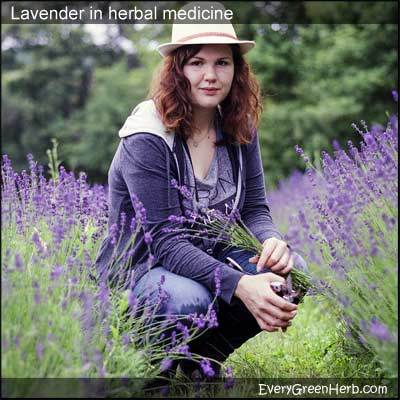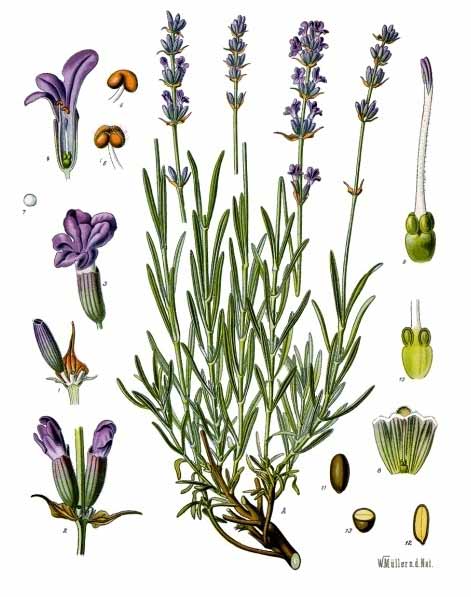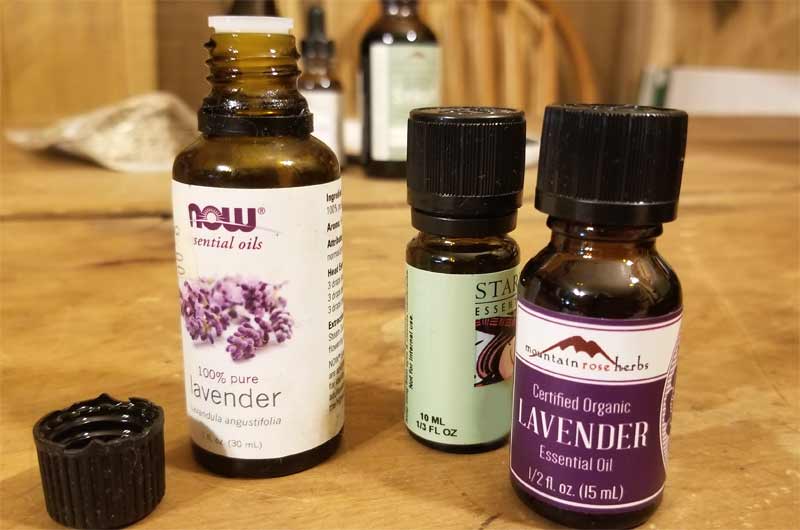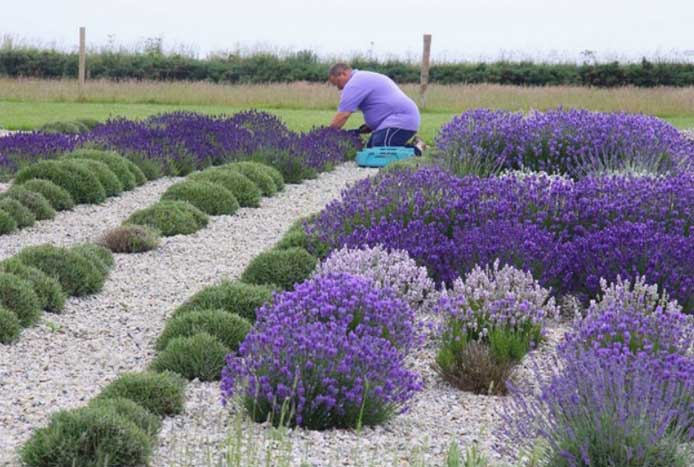Lavender in herbal medicine and aromatherapy

Lavender (Lavandula Augustifolia or Lavender Officinalis) is used to help heal burns, acne, athlete’s foot, dandruff, eczema, psoriasis, boils, abscesses, bruises, and insect bites.
It helps reduce swelling, fungal growths, scarring, and stretch marks.
Lavender also promotes rapid healing and fights infection.
Lavender essential oil can stop headache pain.
Lavender essential oil is often used to treat headache pain.
At first sign of a headache, I apply a drop on my wrists, both temples, and the back of my neck, being careful not to get it in my eyes. I might drink a cup of white willow bark tea (or take an aspirin). Then I go relax in quiet, dark room while inhaling the lavender vapors.
If nausea is present, I add ginger to my tea, or chew crystallized ginger pieces. Positive results are noticeable within fifteen minutes.
More about lavender essential oil
A wonderful essential oil is distilled from lavender plants and flowers. Unlike a lot of essential oils, lavender can safely be applied to the skin in its undiluted state (expect around the eyes). Just dab it neat on a bee sting or bug bite for immediate relief.
The scent of lavender can be surprising because it is not sweet or floral. Unlike jasmine and gardenia, lavender is light with sharp, clean undertones.

Lavender oil is the most versatile of all essential oils.
Lavender essential oil is used on the skin, in herbal products, and in aromatherapy.
Lavender essential oil adapts to the user's need bringing relaxation or energy as desired. I use it almost daily, and consider it a blessing in my life.
Lavender oil is an antidepressant, antiseptic, antibacterial, and mildly analgesic which makes it extremely useful in herbal medicine. If you have just one essential oil, make it lavender.
By the way, if you don't know what the words antidepressant, antiseptic, antibacterial, and analgesic mean, you might want to read my glossary of herbal properties.
Lavender essential oil has many uses and should be in every household.
Lavender essential oil should be in everyone’s kitchen, pantry, medicine cabinet, and first aid kit. Reach for it when treating cold sores, scrapes, cuts, skin problems, swelling, bruises, sunburn, and other common complaints.
Also use lavender when wounds are dry to help reduce scarring. Lavender essential oil promotes healing, stimulates growth of healthy cells, relieves fluid retention, and balances the skin’s moisture content.
It aids in the digestion of fats and can help lower blood pressure.
Lavender essential oil is also affordable - one fluid ounce of lavender essential goes a long way.

Clinical trails and research
According to an article by Jeremy Appleton, ND, published in the Natural Medicine Journal, "Lavender oil aromatherapy has been shown to be effective in the management of anxiety and depression and small and medium-sized controlled and uncontrolled clinical trials."
He goes on to say, "Lavender flower and its extracts have been used, both internally and by olfaction, for centuries as a treatment for anxiety and depression. Modern analytical research has identified the main active constituents of the oil; in vitro and animal studies have begun to elucidate mechanisms of action; and controlled clinical trials in humans now document lavender's efficacy, safety, and dose."
So lavender is great for treating anxiety and depression. We knew this all along!
More about lavender
Clinical herbalist and professional member of the American Herbalists Guild, Merry Lycett Harrison, explains some of the many uses of herbs in this video.
The science of lavender
Lavender oil is an effective treatment for neurological problems.
Lavender is shown to be stop mood swings and to have sedative properties.
It is useful as a pain reliever and can stop spasms.
Lavender contains linalool and linalyl acetate which can be rapidly absorbed by the skin. These substances are detected in blood plasma very quickly after external applications like in massage.
Linalool and linalyl acetate work to protect the brain and nervous system due to their strong antioxidant activity.
Lavender can also be inhaled during aromatherapy. This method acts via the limbic system, affecting the amygdala and the hippocampus.
Lavender is effective at relieving depression and anxiety. In trials, lavender has shown to be useful in the treatment of insomnia, menopausal symptoms, dementia, pain, ulcers, and post-traumatic stress disorder.
More quality research is needed to draw specific conclusions, but I already know that lavender is good for the body, the mind, and the spirit.
Lavender essential oil is good for nerves and digestion.
This volatile oil contains more than 100 chemical compounds that help to calm the central nervous system. Lavender essential oil helps regulate the nervous system, regulate blood sugar levels, and regulate blood pressure.
Use in aromatherapy and massage to clear the head and relax the muscles.
It is good for the digestive tract (lavender aids in the digestion of fats) and respiratory system.
Use as soothing rub for arthritis and rheumatism (mix with rosemary essential oil, frankincense essential oil , and a good carrier for best results).
Lavender essential oil promotes restful sleep and helps relieve stress.
Lavender helps alleviate stress and reduces nervous tension. Try tying lavender flowers up in a piece of cheesecloth or other thin material and putting under your pillow at night. It helps bring a restful sleep.
Lavender essential oil makes a wonderful massage oil when combined with olive or grape seed oil. Lavender essential oil is a wonderful emotional healer.
Use ten drops of lavender essential oil in an herbal bath when treating mild depression, nervous tension, and stress.
When used in aromatherapy, lavender brings about feelings of well-being and stability. It is very useful for people for people with insomnia and sleeping disorders

Lavender oil energizes the body.
Lavender has the unique property of energizing the body or relaxing the body, depending on need. If you need to rest, inhale the aroma of lavender. If you need energy, inhale the aroma of lavender. I keep a bottle of lavender essential oil on my desk and sniff it several times a day.
Lavender essential oil blends well with other oils.
Blend lavender with eucalyptus essential oil when treating asthma, flu symptoms, bronchial problems, and hay fever.
Blend with sweet marjoram for pain relief from sprains, bruises, and painful periods.
Mix lavender essential oil with chamomile or calendula oil when treating eczema.
Add to water for relieving sunburn or scalds.
Add lavender essential oil to hair rinse when treating scalp problems like dandruff or head lice.
Add to other herbal products including lotions, shampoos, ointments, rinses, and muscle rubs whenever you need the healing properties of lavender.
Use as insect repellant.
Use lavender essential oil before the bugs bite! Lavender essential oil is used to repel moths, fleas, silverfish, chiggers, mosquitoes, and flies.
Just rub a few drops on exposed areas like neck, ankles, and arms or use in a spray bottle for easy application.
If you don't have lavender essential oil on hand, but happen to have the plant growing in your garden, you are good to go. Just make a strong lavender tea and use in a spray bottle as needed when outdoors.
Lavender has many uses.
Lavender leaves and flowers can be used in tinctures, teas, infused oils, vinegars, bath salts, scent pillows, and more.
Some people even add lavender to stews, soups, and other culinary creations. Personally, I don't use much lavender when cooking.
Lavender essential oil can be used in aromatherapy, herbal ointments, creams, massage oils, lotions, beauty products, perfumes, and more. It is a basic ingredient in many fragrances, cosmetics, mouthwashes, smelling salts, skin tonics, and furniture polishes. Like all essential oils, it is an amazing substance.
Lavender has been used for centuries to relieve fainting spells. Tinctures were made out of lavender flowers to use as mouthwash although I think the taste is a little like soap and not very pleasant.
There are many non-medical uses for lavender oil. It can be rubbed into oak furniture to give a high gloss and used in household cleansers. You can even add a few drops of lavender essential oil to acrylic and oil paints. It helps reduce smelly fumes.
Lavender is not usually taken by mouth or used in teas.
Do not take more than a drop or two of lavender essential oil internally.

Lavender plants prefer soil that is on the dryer side.
Lavender plants are easy to grow in most home gardens although they do prefer full sun and low humidity. The lavender plant makes a fine addition to the home garden, and it attracts bees.
Lavender is a woody perennial that grows from one to four feet tall. The fragrant blossoms are deep purple to bright blue. The leaves are gray green.
Lavender requires full sun and rapidly draining soil. If you have clay soil, add some sand or gravel before attempting to grow lavender.
Lavender plants do not do well in long periods of high humidity. Propagate from seeds or stem cuttings.
Solutions for growing lavender in humid areas
Lavender can be difficult to grow in the humid conditions of southern summers. Raised beds offer a solution for drainage problems and a mulch of pea gravel or flat stones can help keep things dry.
Heat reflecting from rocks keep the foliage from becoming a breeding ground for mold and mildew. Placing plants far enough apart so that air can freely circulate is also recommended.
Lavender plants rarely need fertilizer. Growing lavender is worth the extra effort as it makes a beautiful addition to the herb garden or flower border, and the herbal medicine cabinet.
Lavender has a long history.
Lavender has been used as a herbal remedy for over 2000 years. The Egyptians used lavender in the mummification process. The Phoenicians used lavender to freshen the air and in their baths.
The word lavender comes from the latin word "lavare" which means to wash. Romans used lavender in the bath, to scent their laundry, and as a remedy for itchy scalp.
It was also used medicinally throughout the centuries to help heal wounds and fight infections.
*Avoid high does of lavender essential oil during pregnancy. Keep all essential oils away from the eyes.
Do not take essential oils internally without consulting a qualified professional. Always dilute essential oils with good carrier oil (such as almond oil) and test on small area of skin before use.
Always consult with a healthcare professional before using any herbal remedy especially if pregnant, nursing, or taking other medicines.
Sources:
https://www.ncbi.nlm.nih.gov/pmc/articles/PMC3612440/
https://www.nccih.nih.gov/health/lavender
Blessings to you and yours!
Thanks so much for reading my blog. Jan.

*Note - the information on this website has not been evaluated by the Food and Drug Administration.
© 2005-2024 website design and content by Janice Boling